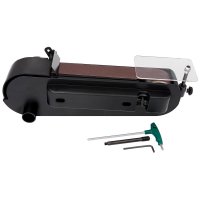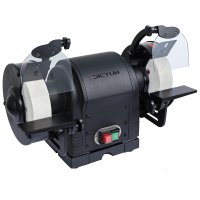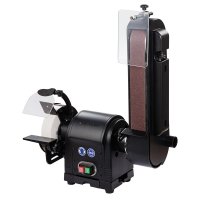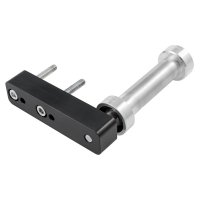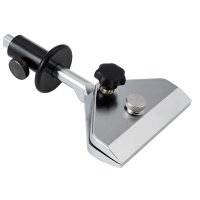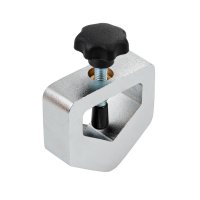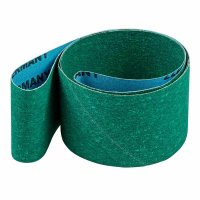
Types of bevels on knife blades
Most knives have a primary and a secondary bevel. The secondary bevel is significantly smaller than the primary bevel. This speeds up the sharpening. Blades subjected to more considerable strain often have a simple grind with continuous, straight bevels (e.g., Scandi grind for carving knives) or a convex bevel (e.g., for outdoor knives and axes). To achieve a sharp cutting angle that facilitates penetration into the material, some blades are given a slight hollow bevels (e.g., scalpels).

The geometries of knife blades can vary greatly
To sharpen these different grinds, several machines were previously necessary. On a so-called grinding bench or double-wheeled grinders, blades always get a hollow grind due to the round shape of the grinding wheel. Belt grinders or sharpening systems with laterally coated grinding wheels are used to grind straight bevels. There have only been compromise solutions for the convex grind so far, as all grinding machines and systems always leave facets on the edge. A truly facet-free convex grind was only possible by hand.
DICTUM Low-Speed Grinder becomes a grinding station
With the Belt Grinding Device BS 50/55, the DICTUM low-speed grinder DS 150 L becomes a versatile grinding station, with which you can realize all the grinds mentioned. The belt grinder extension is mounted on the right side of the low-speed grinder and replaces the grinding wheel that is standardly attached there. The assembly is simple and can be completed with some skill in about 30 minutes. In our YouTube-video (in German), we show you how it's done. The function of the left grinding wheel remains unchanged. The Low-Speed Grinder and belt grinder extension are also available together in a set. The tool rest included with the belt grinder extension can be adjusted in angle and allows simple sharpening tasks to be implemented.

The BS 50/55 is mounted in place of the right grinding stone on the DS 150 L

The sharpening device is compatible with numerous grinding guides
The Sharpening Device for BS 50/55 is attached to the inside of the belt grinding setup. Through the interaction of the mounting plate, cross slide, and boom arm, the guide bar can be precisely positioned and the distance to the grinding belt aligned so that repeat accurate sharpening processes are possible. With a diameter of 12 mm, the guide bar is compatible with numerous grinding guides, in which you can clamp and sharpen different tools and knives. The irons of many hand planes have a width of more than 50 mm. They can also be ground on the BS 50/55 if grinding belts with a width of 55 mm are used (e.g., Klingspor grinding belt CS 931 JF).
Sharpening device for convex bevels
Tools that need very robust edges are often "convex ground." Here, the cutting edge transitions into the blade thickness in a harmonious curve, so that the occurring forces can optimally distribute. So far, facets on the blade have always resulted from machine grinding of convex edges, as flat or concave abrasives (grinding wheels or belts) are used. If the Sharpening Device for convex bevels is mounted, a space is created under the grinding belt. This allows the grinding belt to adapt to the blade shape, resulting in a facet-free convex grind.

With the sharpening device for convex bevels, a facet-free grind is achieved
The sharpening device for convex bevels can either be mounted on the mounting beam of the sharpening device or with the help of a Mounting Base on the belt grinder extension. In both cases, you can align the band run roller parallel to the belt grinder extension using set screws.
Direction of the grinding belt
On the BS 50/55, you can sharpen with or against the direction of the grinding belt. When grinding against the direction, more material is removed, accelerating the sharpening process. We recommend clamping the tool when sharpening against the direction in a grinding guide (e.g., DICTUM Short Tool Jig SW-36).
To sharpen with the direction, the belt grinder extension can be aligned horizontally to the worktable. Material removal and burr formation are slightly less when grinding in the direction, the grinding result can be better controlled, and the grinding is safer. We particularly recommend grinding in the direction when sharpening freehand.

The horizontally aligned BS 50/55 facilitates grinding in the direction of the belt
Tips for sharpening with the belt grinder extension
- Use 55 mm wide grinding belts for wide plane irons
- Use the scale on the sharpening device and note their values and the settings of the grinding guide used to precisely repeat grinds
- A dust extraction system can be connected to the BS 50/55; use a spark-proof extraction system (explosion-protected); do not connect dust extractors that are also used in woodworking (fire hazard!)
- Avoid overheating and annealing the blade by grinding too long; maintain contact with the tool with a finger to feel its temperature and cool it in water if necessary; the finer the grit of the grinding belt, the more heat is generated!

